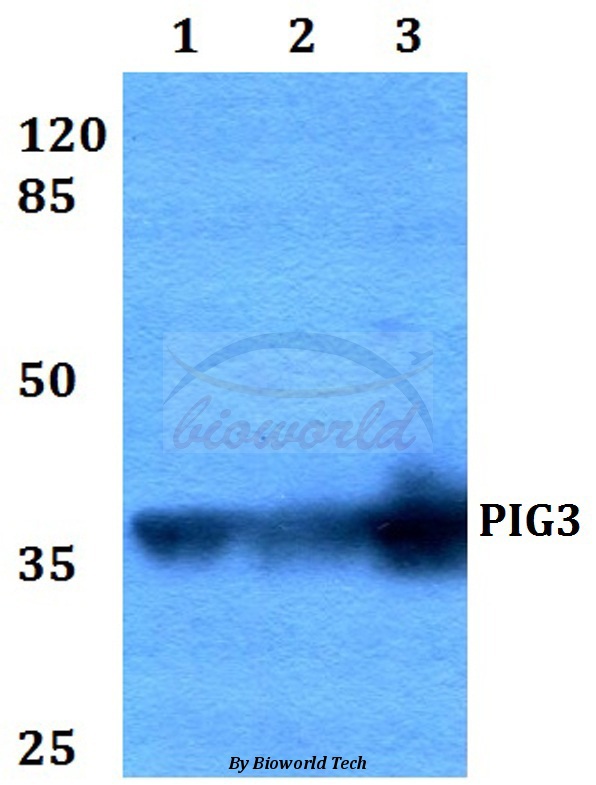Product Name :
PIG3 (L265) polyclonal antibody Background :
The PIG (p53-induced gene) gene family encodes redox-controlling proteins that are involved in p53 tumor suppressor activity. One member of the PIG gene family, p53-inducible gene 3 (PIG3), is a p53 responsive gene that maps, in humans, to chromosome 2p and encodes a protein with significant homology to oxidoreductases. Oxidoreductases are enzymes involved in cellular responses to oxidative stress and irradiation, and they influence the involvement of PIG3 in the metabolism of reactive oxygen species. PIG3 is localized to the cytoplasm and induced in primary, non-transformed, and transformed cell cultures after exposure to genotoxic agents. The induction of PIG3 is p53 dependent and occurs with delayed kinetics as compared with other p53 downstream targets. PIG3 may act with caspase-8 as a key regulatory element in p53-dependent transcriptional deregulation by triggering the caspase cascade and mitochondrial breakdown. PIG3 is highly up-regulated by p53 and may be useful for detecting transient activation of p53. Product :
Rabbit IgG, 1mg/ml in PBS with 0.02% sodium azide, 50% glycerol, pH7.2 Storage&Stability :
Store at 4°C short term. Aliquot and store at -20°C long term. Avoid freeze-thaw cycles. Specificity :
PIG3 (L265) polyclonal antibody detects endogenous levels of PIG3 protein. Immunogen :
Synthetic peptide, corresponding to amino acids 230-286 of Human PIG3. Conjugate :
Unconjugated Modification :
Unmodification
PIG3 (L265) polyclonal antibody Background :
The PIG (p53-induced gene) gene family encodes redox-controlling proteins that are involved in p53 tumor suppressor activity. One member of the PIG gene family, p53-inducible gene 3 (PIG3), is a p53 responsive gene that maps, in humans, to chromosome 2p and encodes a protein with significant homology to oxidoreductases. Oxidoreductases are enzymes involved in cellular responses to oxidative stress and irradiation, and they influence the involvement of PIG3 in the metabolism of reactive oxygen species. PIG3 is localized to the cytoplasm and induced in primary, non-transformed, and transformed cell cultures after exposure to genotoxic agents. The induction of PIG3 is p53 dependent and occurs with delayed kinetics as compared with other p53 downstream targets. PIG3 may act with caspase-8 as a key regulatory element in p53-dependent transcriptional deregulation by triggering the caspase cascade and mitochondrial breakdown. PIG3 is highly up-regulated by p53 and may be useful for detecting transient activation of p53. Product :
Rabbit IgG, 1mg/ml in PBS with 0.02% sodium azide, 50% glycerol, pH7.2 Storage&Stability :
Store at 4°C short term. Aliquot and store at -20°C long term. Avoid freeze-thaw cycles. Specificity :
PIG3 (L265) polyclonal antibody detects endogenous levels of PIG3 protein. Immunogen :
Synthetic peptide, corresponding to amino acids 230-286 of Human PIG3. Conjugate :
Unconjugated Modification :
Unmodification
-
 Western blot (WB) analysis of PIG3 (L265) polyclonal antibody at 1:500 dilution Lane1:HEK293T whole cell lysate Lane2:Raw264.7 whole cell lysate Lane3:H9C2 whole cell lysate
Western blot (WB) analysis of PIG3 (L265) polyclonal antibody at 1:500 dilution Lane1:HEK293T whole cell lysate Lane2:Raw264.7 whole cell lysate Lane3:H9C2 whole cell lysate
Gankyrin gene deletion followed by proteomic analysis: insight into the roles of Gankyrin in Tumorigenesis and Metastasis
PMCID: Pubmed No.:22913272
p53 activation contributes to patulin-induced nephrotoxicity via modulation of reactive oxygen species generation
PMCID: Pubmed No.:27071452
p53 activation contributes to patulin-induced nephrotoxicity via modulation of reactive oxygen species generation
PMCID: Pubmed No.:27071452
Combination of Patulin and Chlorpyrifos Synergistically Induces Hepatotoxicity via Inhibition of Catalase Activity and Generation of Reactive Oxygen Species
PMCID: Pubmed No.:31537057
Bioworld Biotech only provide peptides for our antibodies and do not provide additional peptide customization services.
Price/Size :
USD 368/1mg/vial
Tips:
For phospho antibody, we provide phospho peptide(0.5mg) and non-phospho peptide(0.5mg).Describe :
Blocking peptides are peptides that bind specifically to the target antibody and block antibody binding. These peptide usually contains the epitope recognized by the antibody. Antibodies bound to the blocking peptide no longer bind to the epitope on the target protein. This mechanism is useful when non-specific binding is an issue, for example, in Western blotting (WB) and Immunohistochemistry (IHC). By comparing the staining from the blocked antibody versus the antibody alone, one can see which staining is specific; Specific binding will be absent from the western blot or IHC performed with the neutralized antibody.Formula:
Synthetic peptide was lyophilized with 100% acetonitrile and is supplied as a powder. Reconstitute with 0.1 ml DI water for a final concentration of 10 mg/ml.The purity is >90%,tested by HPLC and MS.
Storage:
The freeze-dried powder is more stable. For short time at 2-8°C. For long term storage store at -20°C.
Note :
This product is for research use only (RUO only). Not for use in diagnostic or therapeutic procedures.
 PIG3 (L265) polyclonal antibody
PIG3 (L265) polyclonal antibody  Datasheet
Datasheet COA
COA MSDS
MSDS SHIP
SHIP